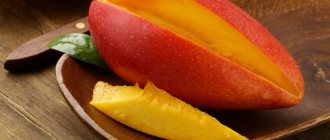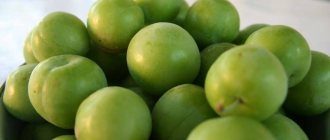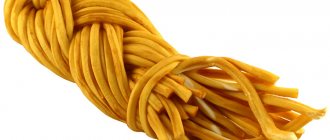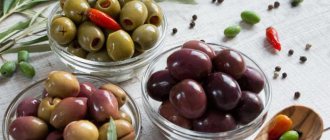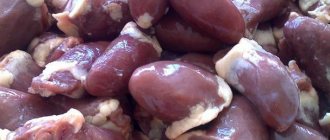Cooking technology
The dried fruit is made from the juicy and ripe fruits of the mango tree. They are carefully peeled and then cut into thin strips. They are placed in a dryer, where the product gets rid of excess moisture. After this, the slices are coated with a thin layer of special oil made from rice bran. This allows you to preserve the natural color, and, importantly, the original beneficial properties, which are literally “sealed” in the dried fruit.
It should be noted that no sugar is used in the production of this delicacy - there is no need for it due to the taste of the fruit. However, like other candied fruits, dried mango has almost five times more calories than fresh fruits.
Chemical composition and calorie content
Calorie content of dried mango (100 g) - 314 kcal.
Dried fruits contain a huge amount of vitamins, amino acids, as well as macro- and microelements. So, this dried fruit contains vitamins A, , , , , , B12, and. In addition, it is high in calcium, iron and phosphorus. This fruit is very rich in potassium, which is essential for the heart muscle. It also contains poly- and monounsaturated fatty acids.
100 g of product contains 1.48 g of protein, 0.78 g of fat and a lot of carbohydrates - 81.61 g.
Mango calorie table
Mango is considered a low-calorie fruit, so it can be consumed by those who want to lose weight. Below is a mango calorie table that will help you get familiar with the world of beneficial and nutritional properties of this amazing fruit.
| Product | 1 PC | 100g | 1 package (250 g) |
| Calorie content of fresh mango (yellow) | 180 | 60 | — |
| Calorie content of dried mango (dried fruit) | — | 314 | 785 |
| Calorie content of candied mango | — | 285 | 712 |
| Calorie content of Thai mango | 210 | 70 | — |
How to select and store dried mangoes
In order for dried fruit to be not only tasty, but also healthy, you should approach the choice responsibly. Do not be tempted by dried slices of a very bright, intense orange or sunny yellow color. The fact is that to give them such attractive shades, they were most likely treated with sulfur dioxide.
On packaging this substance may be designated as preservative E220. Sulfur dioxide has the property of preventing the development of harmful microorganisms in dried fruits, thereby increasing shelf life. In addition, after processing, dried fruits do not darken, acquiring a bright, “chemical” color.
However, the problem is that sulfur dioxide is a highly toxic compound. When it enters the human body, it causes a number of unpleasant consequences. For example, after eating bright, delicious dried fruits, you may soon feel severe discomfort in the throat and upper respiratory tract. A cough, unexpected runny nose, and headache appear. The voice “sits down.” Poisoning with high concentrations of sulfur dioxide can cause suffocation and pulmonary edema.
Therefore, when choosing dried mango, you should buy a fruit that is pale golden in color and as natural as possible.
Store dried fruit away from products with intense odors, in a dark, ventilated area. The maximum air temperature is 22 °C.
Product benefits
Wonderful taste is not the only positive characteristic of this product. Like fresh fruits, dried fruits have a wide range of beneficial properties for human health.
First of all, the benefits of dried mango are due to the presence of a high concentration of dietary fiber in it. They are able to work as an effective adsorbent, absorbing toxins, waste and poisonous substances and removing them from the body. As a result, the functioning of the gastrointestinal tract is normalized, the feeling of heaviness in the stomach and digestive problems go away. This leads to improved skin condition and normalization of the sebaceous glands.
In addition, the beneficial effects of dried mango on the cardiovascular system have been proven. Due to its high iron content, this dried fruit prevents the development of anemia, helping to maintain blood hemoglobin at an appropriate level. It also normalizes blood pressure and prevents the development of atherosclerosis, improving the condition of blood vessels.
The absence of cholesterol in this delicacy makes it an indispensable product for adherents of a healthy diet. In turn, the high content of phosphorus and calcium helps speed up metabolism, reduces the likelihood of catching colds or infectious diseases, improving the body's resistance.
It is difficult to overestimate the benefits of dried mango for the nervous system. This dried fruit helps get rid of sleep problems, get out of stress and prolonged depression. Treat yourself to this sweet treat if you suffer from burnout syndrome and chronic fatigue, attention deficit disorder, problems with memory and reaction speed.
And finally, dried slices are a real storehouse of vitamins. 100 g of this dried fruit contains one fifth of the daily requirement of vitamin A, which is involved in cell regeneration processes and is responsible for the body’s resistance. In turn, vitamins B and D help improve cognitive functions, and vitamin B6 takes an active part in the synthesis of serotonin.
Beneficial features
Eating mango fruits improves the functioning of the cardiovascular system and prevents heart disease, stimulates metabolism, reduces the level of “bad” cholesterol, and has a positive effect on vision and skin health. The aromatic pulp helps get rid of indigestion, reduces stomach acidity, and is recommended for fever, respiratory diseases, gum inflammation, and kidney diseases. Mango strengthens the nervous system and strengthens the immune system, increases resistance to viruses and microbes, disinfects and cleanses the intestines, and is used as a hemostatic and diuretic.
Regular consumption of mangoes protects against colds and flu. The pulp of the fruit contains tryptophan, which is associated with serotonin (the hormone of happiness) and helps relieve stress and tension and improve mood. All this helps to increase performance and improve mental activity. Mango has an antipyretic effect, saturates the body with vitamins and increases overall tone during illness. The substances contained in the fruit have a beneficial effect on the development of the fetus and placenta, so mango is very useful for pregnant women.
Contraindications and harmful properties
However, despite such an impressive list of beneficial properties, there are a number of contraindications for consuming dried mango.
First of all, people suffering from diabetes should avoid this dried fruit. This is due to the increased sugar content in the flavorful slices.
For the same reason, they are not the best choice for those trying to lose weight.
We also note that, like any exotic fruit, mango, even in dried form, can cause an allergic reaction. True, for this you should consume a very significant amount of this delicacy.
How to choose a ripe mango?
Choosing a delicious ripe mango is very simple and the color of the fruit is not an indicator at all.
Fruits, depending on the type of variety, as well as the area where they grow, can have different colors, from traditional green and green-beige, to green-red and even purple. Something else is important here.
1. Feel the mango. Ripe fruits can be pressed and are soft, but at the same time retain their elasticity.
If you pressed and your finger pressed through the fruit, it is already overripe and rotting; if the fruit has returned to its original position, despite the fact that it is soft, you can safely buy it and enjoy the juicy taste.
2. Inspect the fruits you are purchasing. Externally, they should be without damage or dents, shiny and with a dense peel. If there are wrinkled fruits in front of you, do not be deceived and do not listen to anyone, these are stale fruits.
They will no longer be tasty and juicy as we would like, but at the same time they are perfect for making some desserts or baked goods.
3. Smell the mango at the stem area. The most beautiful sweet aroma of the fruit should come from this place.
Attention! If you purchased an unripe mango, do not worry, this fruit will ripen very quickly, the main thing is to put it in a warm place, wrapped in any natural fabric or ordinary newspaper.
How to eat mango correctly?
Use in cooking
Dried mango is a wonderful snack in itself. In addition, this dried fruit is widely used in cooking.
Thus, manufacturers of breakfast cereals and muesli actively add it to their products. Due to its high sugar content, it works as a natural sweetener. In addition, dried fruit can be used to prepare fruit salads and desserts, as well as as one of the components of homemade baking.
More fresh and relevant information about health on our Telegram channel. Subscribe: https://t.me/foodandhealthru
We will be grateful if you use the buttons:
Application
Delicious and aromatic mango pulp serves as a delicious delicacy and an excellent dessert. This fruit is eaten fresh and canned in sugar syrup, and it is also dried and pickled. Mango is used to make jam, jelly, marmalade, confiture, preserves, filling for sweet pastries, and is added to fruit salads and ice cream. Juicy mango pulp serves as a raw material for the production of juices, liqueurs and soft drinks.
Market Analytics
- COVID-19 is changing the rules of the game in the cosmetics market
- Beauty of the future: cosmetic innovations 2020
- New ingredients are the driving force of the cosmetics industry
Convenient search for beauty salons on our website
Beauty salons in Moscow Beauty salons in St. Petersburg Beauty salons in Ekaterinburg Beauty salons in Novosibirsk
Latest blog posts on our website
- Naturecream / Geranium (Pelargonium) oil for skin health and beauty
- Prostye-sovety / Save on a beauty salon: procedures that can be done at home
- Naturecream / Growth Factor - brings back youth?
- Oksana-Lezina / 3 effective abdominal exercises from a fitness instructor for beginners
- Prostye-sovety / Making perfect curls at home
- Prostye-sovety / Which hair removal method to choose
- Naturecream / Wrinkles Puppets
- Naturecream / PEPHA-TIGHT - instant skin lifting
- Naturecream / Blue light - a danger to the skin
- Naturecream / Cocoa Butter – A treat for the skin
Latest forum topics on our website
- Mrs._Smith / Badly sunburned! What to do?((
- Ice / Is it necessary to combine fitness classes with a diet?
- Antonova / What can be used for hair loss?
- Radio operatorKat / Who was on a protein diet?
- Suzanna / Mesotherapy on the face
Other articles in this section
| Marang Marang is adjacent to such fruits as cempedak, jackfruit, durian and has a similar structure and chemical composition of the pulp. Marang fruits are oval-shaped, greenish-yellow in color and small in size. When ripe, the fruit weighs about 1 kg and reaches an average of 20 cm in length. Their thick skin is studded with soft spines that harden as the fruit ripens. The white and tender pulp of ripe marang contains large seeds, it is very tasty and exudes a pleasant aroma. Marang is grown mainly for local consumption and is practically not exported to other countries due to its limited shelf life. Fruits picked green will not ripen and will rot. |
| Salak Salak, salacca or "snake fruit" are the fruits of a tropical palm tree. They grow in clusters and are located at the base of the trunk. The brown fruits are oval or pear-shaped, often in the form of a droplet. They have a scaly, rough skin that resembles snake skin. The sweet, aromatic pulp, yellowish-beige in color, has a specific taste and consists of segments containing one easily separated dark seed. The taste of herring varies and depends on where it grows. In Thailand, this fruit is quite sour and resembles gooseberries or sea buckthorn. In Malaysia and Indonesia, the fruit tastes like a mix of pineapple and banana with a slight nutty flavor and peach aroma. |
| Cloudberry Cloudberry is a herbaceous plant and reaches a height of about 35 cm, found in peat bogs, swampy forests and tundra. During the flowering period in mid-summer, one snow-white flower blooms on each stem. By the beginning of autumn, the first harvest appears - quite large, juicy, sweet, amber-colored berries with a subtle amazing aroma. When unripe, cloudberry berries are red in color and resemble raspberries in appearance. Despite the fact that cloudberries are common in the polar-Arctic region, they do not like snow and do not tolerate frost well. Locals call cloudberries marsh amber, marsh guard, northern orange and moss currant. |
| Papaya Juicy and sweet papaya fruits have an attractive aroma. They are closest in shape and chemical structure to melon, but papaya has bright orange flesh with a pink tint. The outside of the fruit is covered with a thick peel; inside there is a large number of seeds. The fruits vary greatly in shape and size, and their weight ranges from 1 to 3-4 kg. The initially green color of the peel changes to golden yellow as it ripens. |
| Blueberry Blueberry is a perennial low-growing shrub, rarely reaching a height of more than 40 cm. Greenish-white flowers with a delicate pink tint appear in May-June and by mid-summer the fruits are already ripening. The berries are round in shape, small, slightly flattened, blue-black with a bluish bloom. The juicy pulp is dark red, sweet and sour, often astringent, and contains many seeds. Blueberries are good honey plants, but the plant needs good light to bear fruit. Productivity is also highly dependent on temperature conditions during flowering and ripening. Blueberries have such a wide range of beneficial properties that they are rightfully considered a medicinal plant. The fruits, leaves and shoots of blueberries are widely used in folk medicine. |
| Kiwi The fruits of the herbaceous vine Actinidia sinensis are kiwi - oblong, oval berries the size of a large chicken egg. They are covered with a fluffy brown skin, under which there is tender juicy green pulp with small seeds, sweet and sour in taste. |
| Cherry plum Cherry plum is a type of traditional fruit plum. This heat-loving and very capricious plant is grown in the southern regions. The fruits of cherry plum are sweet and sour, round in shape, small in size, yellow, pink, red, purple or almost black in color. Tasty and aromatic cherry plum has many medicinal qualities. |
| Black currant Black currant is a lush shrub from the gooseberry family, which has more than 200 varieties. It blooms in May-June with lilac or pinkish-gray flowers collected in drooping clusters. The fruits ripen in the second half of summer; they are a round berry of black or bluish-violet color, juicy, with a characteristic fragrant odor, multi-seeded, and sweet and sour in taste. The leaves and fruits of the plant are used in folk medicine and cooking. |
| Lemon The fragrant fruits of the lemon, rich yellow in color, are oval in shape with one slightly pointed end. The sour and very juicy pulp contains inedible seeds that are oblong in shape and white in color. Ripe fruits have a refined, delicate and very pleasant taste. The thick lemon rind has an uneven, lumpy surface and contains essential oils. This aromatic fruit is used in cooking, cosmetology, medicine and the food industry. |
| Lime Lime is the lemon's closest relative, and although they are very similar, this little citrus can give its big brother a serious run for its money. Thanks to its taste - more sour, but with a piquant bitterness, lime is indispensable in cocktails and salads. The lime pulp is greenish, very juicy, well granulated. The peel is yellowish-green and very thin when fully ripe. |
